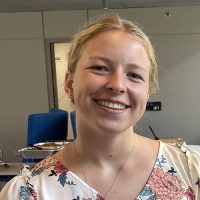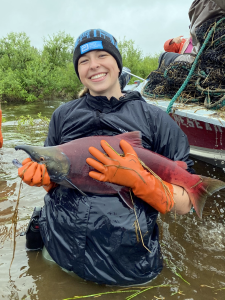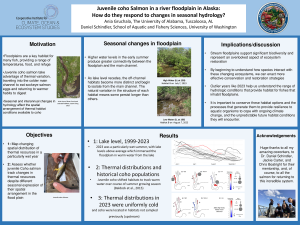
Anna Gruchala
University of Alabama
Research Mentor: Daniel Schindler
Project: Juvenile coho Salmon in a river floodplain in Alaska: How do they respond to changes in seasonal hydrology?
I spent the summer in Bristol Bay, Alaska, working with the Alaska Salmon Program. For eight weeks, I lived in a field camp on Lake Aleknagik. There with me were research scientists and professors from the University of Washington and the University of Alaska Fairbanks, graduate students, ANSEP interns, and field technicians.
Our work varied from day to day and week to week as the weather and conditions changed, but I spent a lot of time outside knee to waist deep in water. My project focused on juvenile Coho salmon in Bear Creek. As the lake level drops in Lake Aleknagik, both the availability of certain habitats and their temperatures changes. We wanted to see how juvenile Coho tracked these changes by netting and measuring them as the season progressed. Juvenile coho rear in freshwater streams for up to three years, and once they’re big enough (typically 2-3 years old), they will leave their  preferred shallow, warm-water habitats to travel into the mainstream, eat sockeye eggs (very nutrient-dense), and then return to their warm waters to digest the food. They do this because they can digest significantly faster in the warmer backwater habitats than they can in the cold main channel of the stream.
preferred shallow, warm-water habitats to travel into the mainstream, eat sockeye eggs (very nutrient-dense), and then return to their warm waters to digest the food. They do this because they can digest significantly faster in the warmer backwater habitats than they can in the cold main channel of the stream.
Outside of my project, I worked on long-term data collection throughout the entire season. My favorite work was the stream surveys we conducted after the sockeye had started spawning. We would spend anywhere from four to eight hours out in the field, walking the length of the stream and counting live fish, fish killed by bears, and fish that died naturally after spawning. It was amazing to see how much each stream in the system differed from the others.
Beyond field and lab work, I also got to learn about fisheries management, see boat yard and talk to people working on commercial fishing boats, interact with people working at Alaska Department of Fish and Game, and learn about what it’s like to grow up and live in Alaska from people of all different ages and demographics.
This year on Lake Aleknagik we saw record-high water levels. Many of the scientists and professors I worked with have been coming up to Bristol Bay for decades, so I got to experience this abnormal year and also learn about how it compared to their past experiences. I came to Alaska having never seen a sockeye salmon before, and left a completely changed scientist, student, and person.

